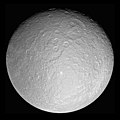Fil:PIA07763 Rhea full globe5.jpg
Hoppa till navigering
Hoppa till sök

Storlek på förhandsvisningen: 600 × 600 pixlar. Andra upplösningar: 240 × 240 pixlar | 480 × 480 pixlar | 768 × 768 pixlar | 1 024 × 1 024 pixlar | 2 048 × 2 048 pixlar | 4 920 × 4 920 pixlar.
Bild i högre upplösning ((4 920 × 4 920 pixlar, filstorlek: 2,67 Mbyte, MIME-typ: image/jpeg))
| Denna fil tillhandahålls av Wikimedia Commons. Informationen från filens beskrivningssida följer nedan. |
Filhistorik
Klicka på ett datum/klockslag för att se filen som den såg ut då.
| Datum/Tid | Miniatyrbild | Dimensioner | Användare | Kommentar | |
|---|---|---|---|---|---|
| nuvarande | 27 augusti 2018 kl. 09.15 |  | 4 920 × 4 920 (2,67 Mbyte) | PlanetUser | Reverted to version as of 08:13, 13 March 2015 (UTC) |
| 15 augusti 2018 kl. 12.09 |  | 4 920 × 4 920 (2,66 Mbyte) | The NMI User | Reverted to version as of 23:49, 14 August 2018 (UTC) | |
| 15 augusti 2018 kl. 01.59 |  | 4 920 × 4 920 (2,64 Mbyte) | The NMI User | rv, fixed | |
| 15 augusti 2018 kl. 01.49 |  | 4 920 × 4 920 (2,66 Mbyte) | The NMI User | Try making black | |
| 15 augusti 2018 kl. 01.44 |  | 4 920 × 4 920 (2,65 Mbyte) | The NMI User | Fixed | |
| 13 augusti 2018 kl. 10.09 |  | 4 920 × 4 920 (3,67 Mbyte) | The NMI User | Removing black borders | |
| 13 augusti 2018 kl. 10.01 |  | 4 920 × 4 920 (2,67 Mbyte) | The NMI User | Reverted to version as of 08:13, 13 March 2015 (UTC) | |
| 13 augusti 2018 kl. 09.56 |  | 4 920 × 4 920 (5,67 Mbyte) | The NMI User | Black background | |
| 13 mars 2015 kl. 10.13 |  | 4 920 × 4 920 (2,67 Mbyte) | MoreTomorrow | making square (to match other planet/moon images) | |
| 30 oktober 2008 kl. 08.43 |  | 4 920 × 4 820 (2,68 Mbyte) | WolfmanSF | This is the same full-resolution NASA image, with black panels added to the margins and some Photoshop processing to enhance contrast. |
Filanvändning
Följande sidor länkar till den här bilden:
Global filanvändning
Följande andra wikier använder denna fil:
- Användande på af.wikipedia.org
- Användande på ar.wikipedia.org
- قالب:المجموعة الشمسية
- قائمة أجرام المجموعة الشمسية مرتبة حسب الحجم
- قائمة أجرام النظام الشمسي المستديرة بالجاذبية
- قائمة الأقمار الطبيعية
- خط زمني لاكتشاف كواكب المجموعة الشمسية وأقمارها
- اكتشاف واستكشاف النظام الشمسي
- قائمة أنواع الكواكب
- بوابة:زحل/مقالة مختارة وصورة لأحد أقمار زحل
- قائمة أكبر الفوهات في المجموعة الشمسية
- 1981 ميداس
- Användande på ary.wikipedia.org
- Användande på arz.wikipedia.org
- Användande på ast.wikipedia.org
- Användande på as.wikipedia.org
- Användande på azb.wikipedia.org
- Användande på be.wikipedia.org
- Användande på bh.wikipedia.org
- Användande på ca.wikipedia.org
- Användande på ckb.wikipedia.org
- Användande på de.wikipedia.org
- Användande på el.wikipedia.org
- Användande på en.wikipedia.org
- Pioneer 11
- Rhea (moon)
- Cassini–Huygens
- Timeline of discovery of Solar System planets and their moons
- List of geological features on Rhea
- Naming of moons
- List of natural satellites
- List of gravitationally rounded objects of the Solar System
- Wikipedia:WikiProject Astronomy/Recognized content
- Portal:Solar System/Selected picture
- User:Dabomb87/Sandbox
- Tirawa (crater)
- Rings of Rhea
Visa mer globalt användande av denna fil.


